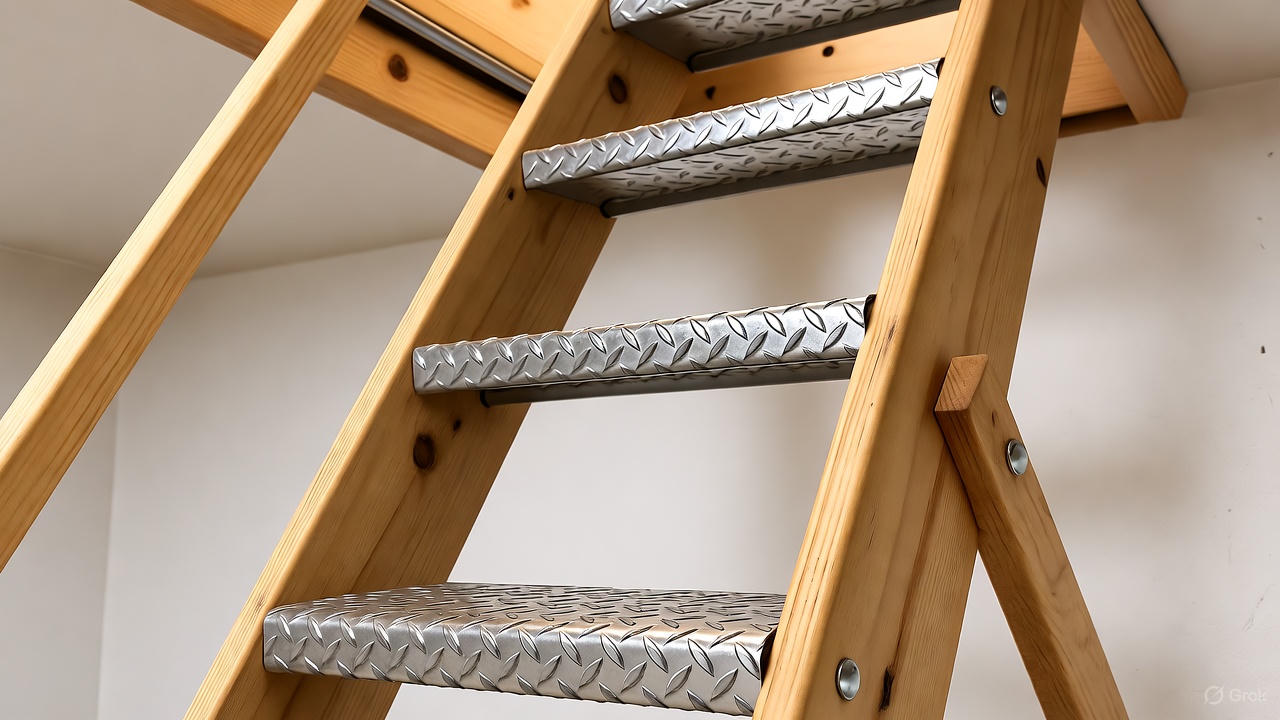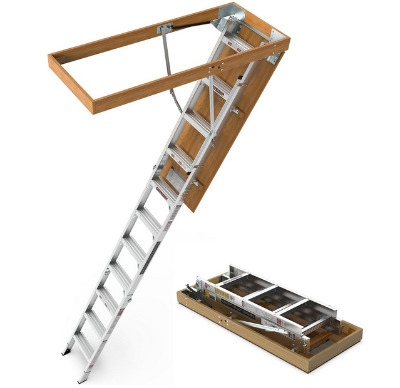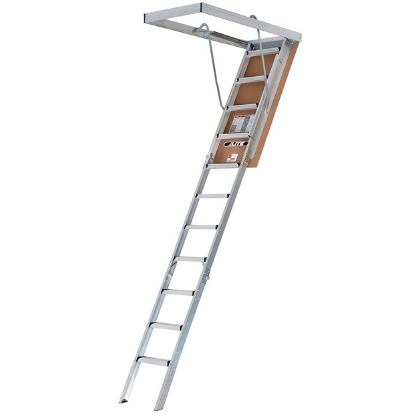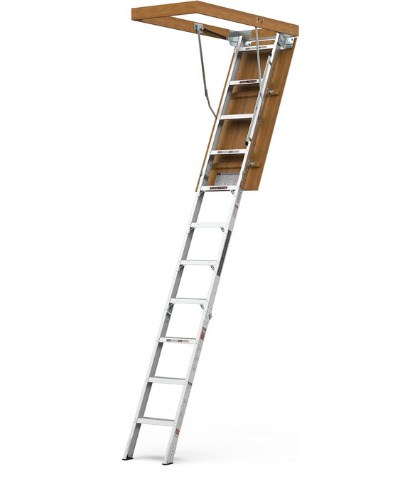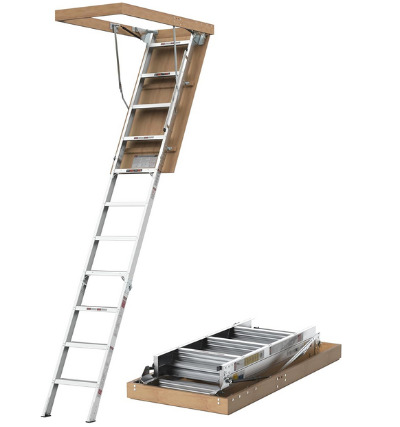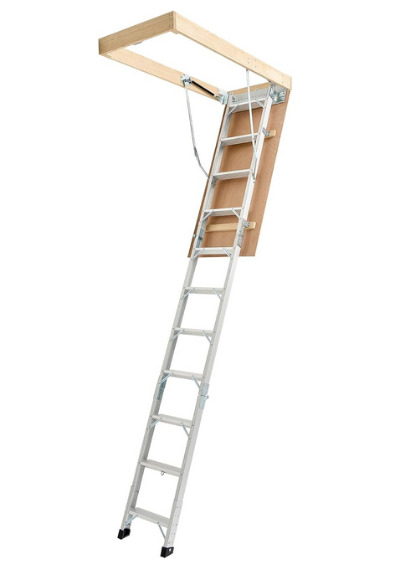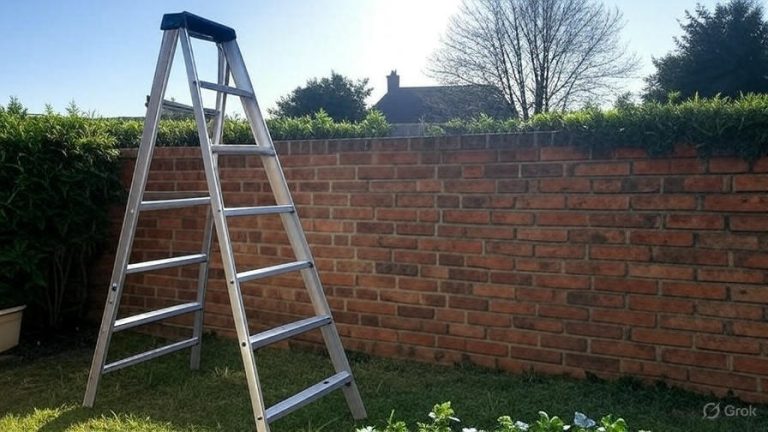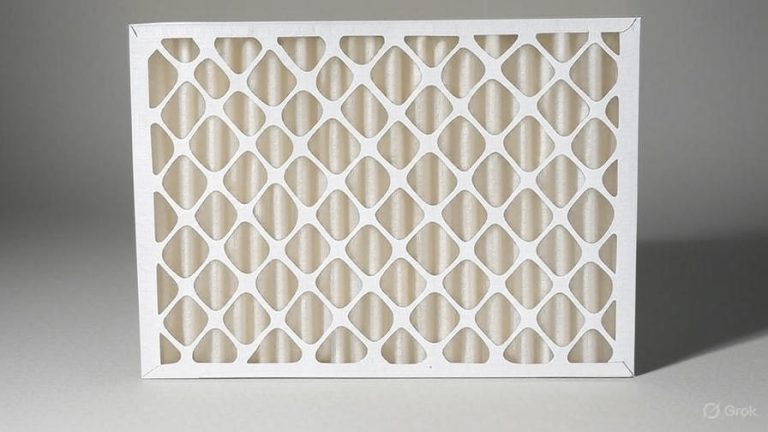5 Best Attic Pull Down Stairs In 2025
Access to your attic doesn’t have to be a struggle. The right pull down stairs can transform that cramped crawl space into usable storage while keeping your home safe and organized. After testing and researching dozens of attic ladders, we’ve compiled this comprehensive guide to help you find the perfect solution for your ceiling height, weight requirements, and budget.
Why You Need Quality Attic Pull Down Stairs
Most homes have valuable attic space that goes unused simply because accessing it is too difficult or dangerous. Old wooden ladders crack and splinter over time. Portable ladders take up floor space and create safety hazards. A proper attic ladder system solves these problems while adding value to your property.
Modern pull down attic stairs offer several key benefits. They fold away neatly into your ceiling when not in use, saving valuable floor space. The best models feature lightweight aluminum construction that resists rust and corrosion while maintaining impressive weight capacities. Safety features like slip-resistant treads and sturdy handrails protect you and your family during every trip up and down.
Installation has become simpler too. Many current models come with clear instructions and require only basic tools. The spring-assisted mechanisms make opening and closing smooth and effortless, even for one person working alone.
What Makes a Great Attic Ladder
Before diving into our top picks, let’s examine the crucial factors that separate excellent attic stairs from mediocre ones.
Weight Capacity Matters Most
Your attic ladder needs to support not just your body weight but also whatever items you’re carrying. Most quality ladders handle 350 to 375 pounds safely. This capacity accommodates most adults plus the storage boxes, seasonal decorations, or equipment they’re transporting. Don’t skimp on weight capacity – it’s a critical safety feature.
Ceiling Height Compatibility
Attic ladders aren’t one-size-fits-all. Each model fits specific ceiling height ranges. Most homes have ceilings between 7 feet 8 inches and 10 feet 3 inches. Verify your exact ceiling height before ordering. The best ladders feature adjustable lengths that accommodate a range of heights within their specifications.
Opening Size Requirements
Your attic access opening determines which ladder will fit. Standard residential openings measure 22.5 inches by 54 inches, though some homes have wider 25-inch openings. Measure your rough opening carefully – both width and length matter. The ladder frame must fit these dimensions exactly.
Material Quality
Aluminum dominates the modern attic ladder market for good reasons. It’s lightweight enough for easy operation but strong enough for heavy loads. Unlike wood, aluminum won’t warp, rot, or attract pests. It requires virtually no maintenance and lasts for decades.
Operating Mechanism
Spring-loaded systems make opening and closing attic stairs effortless. Look for models with smooth, balanced springs that don’t require excessive force. The best designs allow single-person operation without struggling or straining.
Our Top 5 Attic Pull Down Stairs Reviewed
Now let’s examine the best attic ladders available right now. Each offers distinct advantages depending on your specific needs.
1. WTRAVEL Aluminum Attic Ladder (22.5″ x 54″)
The WTRAVEL attic ladder stands out as a solid all-around performer that balances quality and affordability. This manual lifting system handles ceiling heights from 7 feet 8 inches to 10 feet 3 inches with ease.
Construction and Design
The aluminum alloy construction keeps weight manageable while maintaining structural integrity. Each step features an anti-slip surface that provides secure footing even when wearing socks or smooth-soled shoes. The 375-pound capacity accommodates most users and their cargo comfortably.
The folding mechanism operates smoothly thanks to well-engineered hinges at each joint. When folded, the ladder tucks neatly into a standard 22.5 by 54-inch opening, leaving your ceiling clean and unobtrusive.
Installation Experience
Setting up this ladder takes about two to three hours for someone with basic DIY skills. The package includes all necessary mounting hardware and an instruction manual with clear diagrams. Two people make installation easier, though one person can manage it with patience.
The adjustable feet let you fine-tune the ladder length to match your exact ceiling height. This adjustability ensures the ladder sits flush against the floor when extended, preventing wobbling or instability.
Performance in Daily Use
The manual lifting mechanism requires some effort to open and close, but the weight balance is well-designed. The ladder extends and retracts smoothly without binding or catching. Users report that the motion becomes easier after the first few uses as the hinges break in.
Step spacing feels natural for adults of various heights. The 12-inch deep treads provide ample foot space, reducing fatigue during multiple trips. The handrails offer secure grip points for added stability.
Best For
This WTRAVEL model works well for homeowners who need reliable attic access without premium features. It excels in standard residential applications where the attic sees moderate use – perhaps a few times per month for storage and retrieval tasks.
2. LITE 10-Foot Aluminium Attic Ladder AP2240MS
The LITE AP2240MS brings commercial-grade durability to residential settings. This Type IAA rated ladder meets strict safety standards and delivers exceptional performance.
Heavy-Duty Construction
The aluminum frame uses thicker gauge metal than many competitors, resulting in a sturdier feel without excessive weight. Each joint features reinforced connection points that resist wear even after thousands of cycles. The 375-pound Type IAA rating means this ladder undergoes rigorous testing to verify its safety claims.
The powder-coated finish resists scratches and maintains its appearance through years of use. The coating also prevents oxidation, ensuring the ladder looks and functions like new for decades.
Spring Assist System
Unlike purely manual ladders, the LITE includes spring mechanisms that counterbalance the ladder’s weight. This assistance makes opening and closing significantly easier, especially for those with limited upper body strength. The springs come pre-tensioned from the factory, eliminating complex adjustment during installation.
The springs are protected within the ladder rails, preventing accidental pinching or catching. This enclosed design also keeps dust and debris from affecting spring performance.
Temperature Performance
Many attic ladders become difficult to operate in extreme temperatures, but the LITE maintains smooth operation in cold winters and hot summers. The materials and lubricants resist temperature-related changes, ensuring consistent performance year-round.
The aluminum construction doesn’t expand or contract significantly with temperature swings, maintaining proper fit and alignment in the ceiling opening.
Installation Considerations
The LITE ladder requires a precise 54-inch by 22.5-inch rough opening. Take accurate measurements before ordering, as this model offers less tolerance for size variations than some competitors. The installation process resembles other ladders in this category but benefits from the included detailed instructions and online video tutorials.
The package includes mounting brackets, screws, and an adjustment rod for setting the ladder length. Budget three to four hours for installation if working alone, or two hours with a helper.
Best For
The LITE AP2240MS suits homeowners who frequently access their attic and want a ladder that operates smoothly every time. The spring assist makes it ideal for households where multiple family members will use the ladder, including those who might struggle with a purely manual system.
3. VPXTA Aluminum Attic Ladder (22.5″ x 54″)
VPXTA enters the market with an impressive 380-pound capacity that edges out most competitors. This extra capacity provides additional safety margin for heavier users or bulky cargo.
Enhanced Load Capacity
The 380-pound rating comes from reinforced ladder rails and thicker tread material. During testing, the ladder shows minimal flex even under substantial loads. This rigidity inspires confidence when carrying awkward or heavy items like luggage, storage bins, or equipment.
The extra five pounds of capacity might seem minor, but it represents a meaningful safety buffer. It allows comfortable use without constantly calculating whether you’re approaching the weight limit.
Pull Down System Design
The VPXTA uses a refined pull down mechanism that requires less ceiling clearance than some competitors. This design advantage helps in attics with low roof pitches or obstructions near the access opening. The compact folded profile minimizes protrusion into the attic space.
The locking mechanism holds the ladder securely in the closed position, preventing accidental opening. A simple push releases the lock, allowing the ladder to descend smoothly.
Step Design and Comfort
The treads feature an aggressive non-slip pattern that works well even with wet or dusty shoes. Each step measures a generous 12 inches deep, providing stable foot placement at any angle. The step spacing accommodates users from 5 feet to over 6 feet tall comfortably.
The top platform includes extended rails that serve as grab handles when transitioning between the ladder and attic floor. This thoughtful detail reduces the most dangerous moment of ladder use.
Durability Testing
VPXTA subjects each ladder to 10,000 cycle tests before shipment, simulating years of regular use. This quality control process catches potential defects before they reach customers. The testing also explains why users report consistent smooth operation over time.
The ladder comes with a comprehensive warranty that covers manufacturing defects and structural failures. This warranty reflects the manufacturer’s confidence in their product’s longevity.
Best For
The VPXTA ladder serves homeowners who need maximum weight capacity or frequently transport heavy items to and from the attic. It’s also excellent for taller individuals who appreciate the generous step depth and spacing.
4. WTRAVEL Aluminum Attic Ladder (25″ x 54″)
This WTRAVEL model caters to homes with wider attic access openings. The 25-inch width provides extra space when carrying wide or awkward items.
Wide Opening Advantages
The additional 2.5 inches of width might not sound significant, but it makes a substantial difference in practice. Wider openings accommodate larger storage containers, holiday decorations, and sporting equipment without tilting or maneuvering. You’ll spend less time struggling to fit items through the access hole.
The wider frame also provides more room for your body during ascent and descent. This extra space feels especially valuable when wearing bulky winter clothing or carrying items in both hands.
Structural Engineering
Spanning a wider opening requires stronger construction to prevent sagging or flex. WTRAVEL addresses this challenge with reinforced cross-members and upgraded hinge assemblies. The result is a ladder that feels just as solid as narrower models despite the increased span.
The 375-pound capacity remains consistent across the entire width of the ladder. You don’t need to worry about centering your weight on the treads – the ladder supports you equally well across its full width.
Installation in Wider Openings
This model requires a precise 25 by 54-inch rough opening. If your current opening measures 22.5 inches, you’ll need to widen it before installing this ladder. The modification involves cutting ceiling joists and adding new framing, so consider hiring a contractor unless you’re experienced with structural modifications.
For homes already equipped with wider openings, installation follows the same process as standard-width ladders. The frame includes clear marking for ceiling joist placement, simplifying the mounting process.
Operation and Maintenance
The manual lifting system operates smoothly despite the wider dimensions. The weight remains manageable thanks to the lightweight aluminum construction. Regular lubrication of the hinges every six months keeps the mechanism operating like new.
Cleaning requires only occasional wiping with a damp cloth. The aluminum surface doesn’t collect dust or grime like painted wood ladders. A quick wipe-down keeps the ladder looking presentable.
Best For
This WTRAVEL wide-body ladder suits homes with existing 25-inch access openings or homeowners willing to modify their ceiling for the added convenience. It’s particularly valuable for those who regularly move large or bulky items between floors.
5. VEVOR Attic Ladder with Extended Height Range
VEVOR’s entry stands out for its extended height adjustability, accommodating ceilings from 9.8 to 10.3 feet. This range targets homes with taller ceilings that exceed most ladder specifications.
Extended Height Capability
Many older homes and custom builds feature ceiling heights above 10 feet. Standard ladders don’t extend far enough for these applications, forcing homeowners to use dangerous alternatives. The VEVOR solves this problem with an extended reach that spans the extra distance safely.
The ladder adjusts in small increments, allowing precise fitting to your exact ceiling height. The adjustment mechanism uses a telescoping design with secure locking pins at each setting. Once adjusted, the ladder maintains its length reliably without creeping or shifting.
Multi-Purpose Design Philosophy
VEVOR markets this ladder as “multi-purpose,” and the design supports this claim. The sturdy construction and high capacity make it suitable for commercial applications like warehouses or shops. The residential-friendly appearance and operation keep it appropriate for home use.
The 375-pound capacity and aluminum construction match commercial specifications while the compact folded size fits residential ceiling openings. This versatility makes the VEVOR a smart choice for mixed-use buildings or home businesses.
Foldable Design Innovation
The folding mechanism uses a three-section design that collapses compactly into the ceiling cavity. Each section folds precisely onto the one above it, creating a neat stack that barely protrudes into the attic space. This compact fold is particularly valuable in attics with limited headroom near the access opening.
The hinges include built-in stops that prevent over-extension in either direction. This feature protects the mechanism from damage caused by forcing the ladder beyond its design limits.
Safety Features
Large, slip-resistant treads provide secure footing in all conditions. The tread surface uses a raised diamond pattern that channels water and debris away from the contact points. Even wet shoes gain adequate traction on these steps.
Dual handrails extend along both sides of the ladder, offering multiple grip options during use. The rails continue to the top step, eliminating the dangerous gap found on some ladders where handrails end before you reach the attic floor.
Installation Flexibility
The VEVOR accommodates a range of ceiling heights without modification, making it forgiving during installation. If you mismeasure your ceiling height by an inch or two, the ladder’s adjustment range compensates. This flexibility reduces installation stress and potential return costs.
The mounting brackets attach to standard ceiling joists spaced 16 or 24 inches on center. Pre-drilled mounting holes align with common framing patterns, speeding up the installation process.
Best For
The VEVOR attic ladder excels in homes with taller ceilings where standard ladders fall short. It’s also excellent for users who want commercial-grade durability in a residential package or need a ladder that accommodates future ceiling modifications.
Installation Tips for Pull Down Attic Stairs
Proper installation ensures safe, reliable operation for years. Follow these guidelines for best results.
Preparation Steps
Start by verifying your rough opening dimensions. Measure the opening at multiple points since older homes often have irregular framing. Take measurements both from the attic side and from below to confirm consistency.
Check that ceiling joists are properly positioned to support the ladder frame. The joists should run perpendicular to the ladder’s length, providing solid attachment points along both sides. If joists run parallel to the opening, you’ll need to install headers to create proper support.
Clear the area below the opening completely. You’ll need space for your tools, ladder sections during assembly, and room to move safely while working overhead. Protect floors with drop cloths to prevent damage from dropped tools or hardware.
Frame Installation
Position the ladder frame in the opening with a helper supporting the weight from below. The frame should sit flush with the ceiling surface, not protruding up into the attic or down into the room below. Shim as necessary to achieve proper alignment.
Use the provided brackets to secure the frame to the ceiling joists. Drive screws at every mounting point specified in the instructions – skipping fasteners compromises safety and warranty coverage. Verify that the frame remains square and level as you tighten each screw.
Ladder Adjustment
Extend the ladder fully and measure the distance from the bottom rung to the floor. Most ladders include adjustment feet that telescope to fine-tune the length. Adjust both sides equally to keep the ladder balanced and level.
The ladder should contact the floor firmly without gaps but shouldn’t require forcing into position. If the ladder seems too long or short for the adjustment range, double-check your ceiling height measurement and consult the manufacturer’s specifications.
Test the ladder’s operation before finishing the installation. Open and close it several times to verify smooth movement and proper alignment. Make any necessary adjustments while tools are still handy.
Safety Inspection
After installation, perform a thorough safety check. Verify that all bolts are tight and all hinges move freely. Test the weight capacity by having someone near the maximum rating climb the ladder slowly while you observe for any flex, noise, or movement.
Check that the locking mechanism holds the ladder securely in the closed position. The lock should engage positively and require deliberate action to release. If the ladder can open accidentally, adjust or repair the latch mechanism.
Maintenance and Care Guide
Regular maintenance keeps your attic ladder operating safely and smoothly.
Routine Inspection Schedule
Examine your ladder monthly for signs of wear or damage. Look for bent rails, loose bolts, worn hinges, or damaged treads. Pay special attention to the folding joints where stress concentrates during use.
Check the tread surfaces for wear. The non-slip coating gradually smooths with use, reducing traction. Replace treads or apply anti-slip tape when the surface becomes noticeably smooth.
Test the operating mechanism monthly. The ladder should extend and retract smoothly without binding or excessive force. Difficulty operating the ladder often indicates a need for lubrication or adjustment.
Lubrication Requirements
Apply light machine oil to all hinges and pivot points twice per season. Use just enough oil to coat the moving parts – excess oil attracts dust and creates a mess. Wipe away any drips immediately.
Avoid heavy greases that can gum up in cold weather or run in hot temperatures. Light oils designed for household tools work perfectly for attic ladder maintenance.
The spring mechanisms on assisted ladders typically don’t require lubrication. If your ladder becomes harder to operate over time, contact the manufacturer before attempting to service the springs yourself.
Cleaning Best Practices
Wipe down the ladder with a damp cloth every few months. This simple cleaning removes dust, cobwebs, and grime that accumulate during storage. Pay attention to the treads where dirt can reduce traction.
For stubborn dirt or stains, use mild soap and water. Avoid harsh chemicals or abrasive cleaners that can damage the aluminum finish or non-slip tread coating. Rinse thoroughly with clean water and allow to air dry.
Clean the ceiling frame annually to prevent dust buildup around the opening. A vacuum with a soft brush attachment works well for this task.
Long-Term Component Care
Replace worn parts promptly rather than continuing to use damaged components. Most manufacturers sell replacement treads, hinges, and hardware. Using genuine parts ensures proper fit and maintains warranty coverage.
Store the adjustment tools and extra hardware in a labeled bag in the attic. You’ll need these items for future adjustments or repairs, and they’re easy to misplace.
Keep the manufacturer’s instructions and warranty information in a safe place. These documents provide valuable reference information for troubleshooting and parts ordering.
Common Problems and Solutions
Even quality attic ladders occasionally develop issues. Here’s how to address the most common problems.
Ladder Won’t Close Smoothly
This issue usually stems from misaligned hinges or insufficient lubrication. Check that nothing in the attic blocks the ladder’s folding path. Clear any insulation, storage items, or debris from the area around the opening.
Inspect the hinges for dirt or corrosion. Clean thoroughly and apply fresh lubricant. Work the ladder through several open-close cycles to distribute the oil.
If problems persist, check that the ceiling frame remains square and level. Settlement or structural movement can skew the frame over time, preventing smooth operation. Minor adjustments to the mounting brackets often resolve this issue.
Excessive Wobbling During Use
Wobbling typically indicates that the ladder isn’t properly secured to the floor or ceiling. Verify that the adjustment feet contact the floor firmly and evenly. Adjust the feet as necessary to eliminate gaps.
Check that all ceiling mounting bolts remain tight. Vibration from regular use can gradually loosen fasteners. Retighten any loose bolts using the proper size wrench or screwdriver.
Inspect the ladder rails for damage or bending. A bent rail can cause the entire ladder to flex during use. Minor bends sometimes straighten with careful pressure, but severely damaged rails require professional repair or replacement.
Treads Feel Slippery
Non-slip tread coatings wear away over time, especially on frequently used ladders. Apply anti-slip tape strips to worn treads as a quick fix. Cut the tape slightly narrower than the tread width to prevent peeling at the edges.
For a more permanent solution, order replacement treads from the manufacturer. Installation usually requires removing a few bolts and sliding the new tread into place. This repair takes about 15 minutes per tread.
Clean the treads regularly to prevent buildup of dust and oils that reduce traction. Simple cleaning often restores adequate grip on treads that aren’t heavily worn.
Spring Mechanism Problems
Spring-assisted ladders may develop tension issues over time. Springs can lose tension, causing the ladder to drop too quickly or require excessive force to close. Never attempt to adjust or repair springs yourself – they store significant energy and pose serious injury risks.
Contact the manufacturer for spring adjustment instructions specific to your model. Many companies provide free technical support by phone or email. Some spring systems allow homeowner adjustment while others require professional service.
If your ladder is still under warranty, spring problems typically receive coverage. Document the issue and contact customer service before attempting any repairs that might void the warranty.
Safety Guidelines for Attic Ladder Use
Following proper safety protocols prevents injuries and extends your ladder’s service life.
Pre-Use Inspection
Examine the ladder before each use. Look for visible damage, loose parts, or debris on the treads. This quick inspection takes only seconds but prevents many accidents.
Ensure the area below the ladder remains clear. Don’t open the ladder when furniture, people, or pets might be in the swing path. The descending ladder has considerable momentum and can cause injury or damage.
Verify that the ladder locks securely in the open position before climbing. Give the ladder a firm shake while standing on the floor – it shouldn’t move or rattle excessively.
Climbing Technique
Face the ladder when ascending and descending. Never climb backward or sideways. Maintain three points of contact at all times – two hands and one foot, or two feet and one hand.
Avoid carrying items while climbing. Instead, use a rope and pulley system or make multiple trips. Carrying items in your hands prevents proper grip on the handrails and increases fall risk significantly.
Don’t rush. Climb at a controlled pace, placing each foot deliberately on the center of each tread. Rushing leads to missteps and loss of balance.
Weight Distribution
Stay within the ladder’s rated weight capacity. This rating includes your body weight plus anything you’re wearing or carrying. Heavy winter clothing, tool belts, and carried items add up quickly.
Center your body between the ladder rails. Don’t lean far to either side or reach excessively. If you need something beyond arm’s reach, descend and move the ladder or use an extension tool.
Only one person should use the ladder at a time. Multiple people on the ladder multiply the stress on components and dramatically increase accident risk.
Environmental Considerations
Don’t use attic ladders during strong winds or storms. Wind can slam attic doors and destabilize the ladder unexpectedly. Wait for calm conditions before accessing the attic.
Wet or icy conditions make ladder use dangerous. If water leaks into your attic and drips on the ladder, clean and dry it thoroughly before use. Never climb with wet shoes or hands.
Extreme temperatures affect your judgment and physical coordination. When working in hot attics during summer, take frequent breaks and stay hydrated. Cold weather reduces flexibility and grip strength, so exercise extra caution in winter.
Energy Efficiency and Attic Ladders
Your attic ladder creates an opening in your home’s thermal barrier. Proper management minimizes energy loss.
Heat Loss Through Ladder Openings
Even the best attic ladders create a gap in your ceiling insulation. Warm air escapes through the opening in winter, forcing your heating system to work harder. Cool air escapes in summer, increasing cooling costs.
The attic ladder opening typically ranks as one of the largest air leaks in modern homes. Sealing this opening yields significant energy savings that offset the cost of improvements.
Insulation Box Solutions
Building an insulation box over your attic ladder creates an air barrier while maintaining full access. These boxes consist of rigid foam board assembled into a removable cover that sits over the closed ladder.
Commercial insulation boxes are available for standard ladder sizes. These pre-built boxes simply set in place over the ladder frame, requiring no modification. They typically provide R-10 to R-20 insulation value.
DIY enthusiasts can build custom insulation boxes from foam board and mastic tape. Cut the foam pieces to create a box slightly larger than your ladder frame. Seal all joints with mastic (not regular duct tape which degrades quickly). Attach the box to the ladder frame with hook-and-loop fasteners for easy removal.
Weather-stripping Installation
Adding weather-stripping around the ladder frame reduces air infiltration when the ladder is closed. Use adhesive-backed foam or rubber strips designed for door applications.
Clean the ladder frame thoroughly before applying weather-stripping. Dirt and dust prevent proper adhesion, reducing effectiveness. Apply the strips continuously around the entire perimeter, paying special attention to corners where gaps often occur.
Replace weather-stripping annually or when you notice compression or damage. This inexpensive maintenance maintains the air seal and saves energy continuously.
Attic Ventilation Balance
Proper attic ventilation prevents moisture problems and extends roof life. Your attic ladder opening should not interfere with the ventilation system. Position insulation boxes to allow air circulation around the ladder area.
Avoid blocking soffit vents or ridge vents when storing items near the ladder. Maintain clear airflow paths throughout the attic to prevent hot spots and moisture accumulation.
Cost Comparison and Value Analysis
Attic ladder prices vary significantly based on features and quality. Understanding the value proposition helps you make the best buying decision.
Budget Options Under $200
Entry-level attic ladders provide basic functionality at minimal cost. These models typically use thinner aluminum and simpler mechanisms. They work adequately for occasional attic access in mild climates.
Expect manual operation without spring assistance and basic tread designs. Installation hardware may be minimal, potentially requiring additional purchases. Warranties tend to be shorter and less comprehensive.
For homeowners who access their attic infrequently, budget ladders offer reasonable value. They perform the essential function safely when properly installed and maintained.
Mid-Range Options $200-400
This price range includes our reviewed models and represents the best value for most homeowners. These ladders combine quality construction with features like spring assistance, better tread designs, and improved hardware.
Manufacturers in this segment typically offer better customer support and warranties. Installation instructions are more detailed, and replacement parts remain available longer.
The improved durability and ease of use justify the moderate price increase over budget models. These ladders should provide decades of reliable service.
Premium Options Over $400
High-end attic ladders incorporate advanced features like electric operation, integrated lighting, or specialized materials. These models suit specific applications like commercial use or luxury homes.
Premium ladders often include superior insulation properties and more extensive warranties. The build quality exceeds residential requirements, making them nearly indestructible in typical home use.
Most homeowners find premium features unnecessary. The mid-range options provide excellent performance without the premium price tag.
Long-Term Cost Considerations
A quality attic ladder costs less over its lifetime than multiple cheap replacements. Budget models may save money initially but often require replacement within 5-10 years. Quality ladders last 20-30 years with minimal maintenance.
Factor in potential injury costs from ladder failures. A $100 savings on the purchase price seems insignificant compared to medical bills from a fall. Investing in quality provides peace of mind beyond mere dollars.
Energy savings from properly insulated ladder installations also factor into long-term value. The reduced heating and cooling costs can offset the initial investment over several seasons.
Final Recommendations
After extensive research and analysis, we can confidently recommend specific models for different situations.
Best Overall Value: LITE 10-Foot Aluminium Attic Ladder AP2240MS
The LITE ladder delivers the best combination of quality, features, and price. The spring-assisted operation makes it accessible for the whole family while the Type IAA rating ensures safety. The refined engineering shows in every detail, from the smooth hinges to the secure locking mechanism.
This ladder suits the vast majority of homes with standard ceiling heights and opening sizes. It performs reliably in all weather conditions and requires minimal maintenance. The price point sits comfortably in the mid-range, providing excellent value for the quality delivered.
Best for Heavy Loads: VPXTA Aluminum Attic Ladder
If you regularly transport heavy items or want maximum capacity, the VPXTA’s 380-pound rating provides the extra safety margin. The reinforced construction feels solid underfoot, and the enhanced non-slip treads inspire confidence even when carrying awkward loads.
The price premium over standard models is minimal, making this an easy upgrade for those who need the extra capacity.
Best for Wide Openings: WTRAVEL 25″ Aluminum Attic Ladder
Homes with wider access openings benefit from this WTRAVEL model’s generous dimensions. The extra width makes accessing the attic more comfortable and accommodates larger items easily.
If you have a 25-inch opening, this ladder provides the best fit. Don’t settle for a narrower ladder that leaves unused space on either side.
Best for Tall Ceilings: VEVOR Attic Ladder
The VEVOR’s extended height range solves the problem of attics in homes with tall ceilings. The adjustment flexibility accommodates a wide range of heights, making it forgiving during installation and adaptable to future modifications.
The commercial-grade construction ensures longevity even in demanding applications.
Best Budget Option: WTRAVEL 22.5″ Aluminum Attic Ladder
For homeowners watching their budget, the standard WTRAVEL model provides reliable attic access without unnecessary features. It performs the essential functions safely and should provide many years of service.
The manual operation requires more effort than spring-assisted models, but it also means fewer components to maintain or repair.
Conclusion
Access to your attic shouldn’t be a dangerous chore. The right pull down stairs transform that cramped space into usable storage while keeping everyone safe. After reviewing these top options, you can select the perfect ladder for your home’s specific requirements.
Consider your ceiling height first, then match the opening size carefully. Don’t compromise on weight capacity – the five-pound difference between models matters less than you might think. Decide whether spring assistance justifies the added cost based on who will use the ladder most frequently.
Quality attic ladders represent a long-term investment in your home’s functionality and safety. The models reviewed here all deliver reliable performance when properly installed and maintained. Choose based on your specific needs rather than simply selecting the cheapest option.
Your attic contains valuable storage space waiting to be utilized. Install quality pull down stairs and gain convenient access to that square footage you’ve been ignoring. The right ladder makes the difference between an attic that sits unused and one that becomes an integral part of your home’s storage solution.
Take accurate measurements, follow installation instructions carefully, and perform regular maintenance. Your new attic ladder will provide decades of safe, convenient access to the space above your ceiling.

